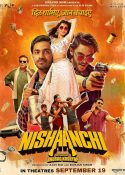 All We Imagine As Light, directed by Payal Kapadia, is a moving exploration of life in contemporary India. With a compelling and contemplative story, this outstanding film features brilliant performances by Kani Kusruti, Divya Prabha, and Chhaya Kadam. The film, which has earned a perfect 100% critics’ score on Rotten Tomatoes, is now playing in New York and Los Angeles with multiple sold-out shows. This Friday, November 22nd, it will open in cinemas in Chicago, Philadelphia, Dallas, San Francisco, and San Diego. More cities will be added over Thanksgiving.
All We Imagine As Light, directed by Payal Kapadia, is a moving exploration of life in contemporary India. With a compelling and contemplative story, this outstanding film features brilliant performances by Kani Kusruti, Divya Prabha, and Chhaya Kadam. The film, which has earned a perfect 100% critics’ score on Rotten Tomatoes, is now playing in New York and Los Angeles with multiple sold-out shows. This Friday, November 22nd, it will open in cinemas in Chicago, Philadelphia, Dallas, San Francisco, and San Diego. More cities will be added over Thanksgiving.
The film, which won the Grand Prize at this year’s Cannes Film Festival, is a soulful study of three women living in contemporary working-class Mumbai. All We Imagine As Light explores their experiences and focuses on the expressions of their individual light. It is complex, beautiful, sad, full of darkness and light, both imagined and real, and it’s utterly brilliant.
Let’s set the scene with the trailer
In this fascinating interview, Payal Kapadia gives insight into creating this special film, which is, by the way, her debut feature film, what it was like to work with the three brilliant actresses, and what light means to her.
Can you tell us how the idea of the story of All We Imagine As Light and then the film came about?
This was a long time from start to finish, actually. But I wanted to explore working in the city and specifically, working in Mumbai. It’s a place where it’s a little bit easier for women to work than in other parts of the country. It actually is very safe for a woman there in Mumbai. You can walk home alone at night. I wanted to explore what it was like for a woman working and living in Mumbai. It is also an exploration of love. Prabha is married to someone she does not know, and he left her. That is considered legitimate. But Anu, who is truly falling in love, her relationship is considered illegitimate. I wanted to explore all that as well.
That opening scene starts as if it were a documentary, with the first shots taking you to the streets, where you experience the bustling areas full of people and hear the sounds of Mumbai, and, weaving through that, you hear stories of people who live there, was such a cool way to set up where you are and get you inside the world. The film transforms into a combination of a documentary feel with a feature film. What was your thought process?
Yes, exactly. The city and the people are alive. The energy is alive. I felt that was needed. You were immersed. There was so much to weave together. So many strands to knit together of the city throughout, but also the stories of the three women. I always like the juxtaposition of fiction and non-fiction. I think it adds to the realness and the truth of the story. I always like when I see a film that there is a mix of those two. I wanted to create that with my first feature film.
As Prabha, Kani Kusruti has this quiet desperation, longing, resignation, and deep sadness. She stays hidden inside herself, but you see all that is happening inside her eyes. How did you work with her to play this role?
Yes, that is so right. She comes from a theatre background, and the way they perform involves a lot of movement. It is a very expressive form of acting. For her, it was not about the lines; it was about the emotion. It is about the character. It was in the eyes, and that came to life in the film.
And you got to do a close-up of that.
Yes! Her face is a map, and it was brilliant.
Divya Prabha as Anu has this joy that just comes off the screen, but she is also great in the more dramatic moments; what was it like to work with her?
I saw her a few years ago in Ariyippu (Declaration), which was selected for Locarno. In that film, she played a very serious role. But then I came across her Instagram, which has almost 300,000 followers. On her Instagram, she has this happy, bubbly energy. It amazed me to see her play this really dramatic role that was so opposite to what she is like on Instagram. I really wanted to explore that Instagram side of her with this role.

In every single role, Chhaya Kadam completely transforms her entire body, eyes, and everything. So tell us about developing that character of Parvaty and working with her.
Yes! She is a legend. I saw her in a Marathi film, Fandry, probably about ten years ago, and it stayed with me since. I was very nervous to approach her. She said yes. She really understood this character. She herself comes from Ratnagiri, and her own village is not far from where we shot. She understood the story because a lot of people from that region came to Mumbai to work in the cotton mills, but then it all changed, which is her character’s experience. She is a legend!
What a gift to work with them on your first feature film.
It really was! They were incredible to work with.
Let’s talk about the lighting and the framing of shots, which I loved. There are so many that stuck with me. So, how do you design a shot, for example, the scarf in the window and the sky full of stars?
Thank you. You know we don’t have dryers in Mumbai, so clothes are hung outside. A sari that is 6 feet long hanging in an apartment is just the world and created a beautiful moment. There were many more quiet, beautiful moments I wanted to capture and include in this film. It was important to me to set the scene and tell the story with those moments interspersed within the film’s action.
Also, I loved that there was darkness in the city (except for artificial light), but when they got to the beach, it was light, sometimes bright light. What made you want to tell the story that way?
Light is emotion to me. When it is cloudy, we say it is a gloomy day, and that is because of the light. When it is sunny out, we say it is a bright sunny day. So light is emotion. The darkness was almost oppressing them in the city except at night in Mumbai — with the lights of the city. That was when Anu and, Prabha and Parvathy could live. One character says, ‘My favorite time is at night’. Then, when they went to the beach, it was bright light because they were finding happiness. The light is another character, and it is an emotion in the film. I liked to explore that. It adds to the mise-en-scène. The light waxing and waning really was another piece of the story.

One of the things that stood out to me was the sound design by Benjamin Silvestre, Romain Ozanne, and Olivier Voisin, and that it was a soundtrack that contributed to the feeling of being in Mumbai and the beach, not just watching it.
Yes, exactly. I always like to use sound as the soundtrack. It is another character. For me, it adds to the immersive feeling of the film as if the sound were a character, a feeling, and as I said, it becomes the soundtrack to the film. Mumbai is really loud; you can hear it even inside your apartment, and the way the sound plays a role was important to me to include. It all added to the essence of the film.
Once you saw it all finally come together, what was your reaction?
There were a lot of scenes I shot that I was not able to use. When we were editing, a lot had to be cut. Scenes I really felt were important. I was really upset at that. In fact, I kept concentrating and worrying about that. However, now that it has been at festivals and well received, I have had to let that go. The reactions of the audience helped me gain some clarity and make peace with it. It has been so well received that I realize that maybe those scenes were not needed. I am very happy with the final product.
I want to thank Ms. Kapadia for the wonderful interview.
Be sure to experience this fabulous movie on the big screen when All We Imagine As Light comes to a theatre near you. I highly recommend it.
Also, check out our rave review.











